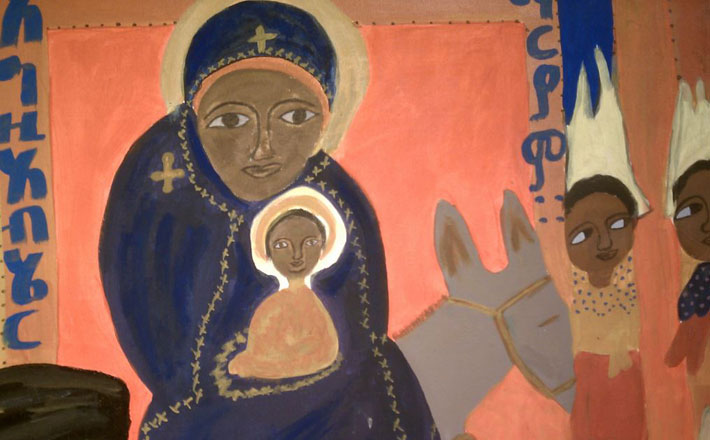Commentary on Luke 2:1-14 [15-20]
Luke’s account of Jesus’ birth is beautiful in its humane simplicity.
Who can forget it? The story unfolds in three clear episodes. We sympathize with Joseph and (especially) pregnant Mary, as they make the journey from Nazareth to Bethlehem, where Mary delivers her first-born son in the lowliest of conditions. We delight in the shepherds and get to share in the angel’s joyful “birth announcement” of the Messiah. Finally, we get to accompany the shepherds to the manger, where they share the remarkable birth announcement to the amazement of all. These are indeed words that we, like Mary, treasure in our hearts.
For all of its simplicity, we must not miss the story’s theological depth, which often lies just below the surface but emerges with some study. It is striking how an event of secular history becomes (providentially) the occasion for the fulfillment of God’s promises. The historical problems regarding the decree of Caesar Augustus and the census of Quirinius are well known (see the commentaries). Putting that problem aside, we note that this decree brings it about that Jesus is born in Bethlehem. Although Luke does not mention it, he surely knows that for the early Christians Jesus’ birth (allegedly) in the “city of David” was viewed as a fulfillment of prophecy (cf. Matthew 2:5-6; John 7:42).
It is probably no accident when Luke tells us that Jesus was born under Caesar Augustus, or that his decree applied to the “whole world.” These data highlight the world-wide significance of Jesus’ birth (contrast the birth of John in 1:57-58, which also happened under Augustus, but which is not given the same significance). The famous Priene inscription (ca. 9 BC), often cited in this connection, speaks of Augustus’s birth as of the birth of a “god” and as the gift of divine providence, who sent him as a “savior,” to bring peace (an end of war). His birthday was “the beginning of good news for the world that came because of him.” Augustus was called “Son of God” in inscriptions and papyri. Yet the angel in our story will declare that the good news (euaggelizomai) is the birth of the Messiah, the Son of God Jesus (1:32). This Messiah will bring ultimate salvation: the forgiveness of sins for all people and deliverance from eternal death. Even if Luke did not know the Priene inscription specifically, it is difficult to imagine that he was unaware of the ideas it contained. Jesus’ birth counters the suggestion that the world’s hopes might lie in the hands of the rulers of this age. The world’s hopes lie in him.
Just as Jesus is born in humble circumstances, so the first to hear the good news of his birth are lowly shepherds: Jesus came for such humble folk as these (Luke 4:18). That the shepherds were the first to hear the news of Jesus’ birth because the manger in which he was born was theirs is a charming though unprovable thought.1 In any case, the angel tells the shepherds that they will see a sign confirming the birth of the Messiah: an infant wrapped in swaddling clothes and lying in a manger. With this mention of a “sign” Luke picks up a motif from the Old Testament, where God or a prophet announces a sign that will confirm the truth of some act or promise of God (e.g., Exodus 3:12; 1 Samuel 2:34; 10:1; Isaiah 37:30; 38:7). One thinks here particularly of Isaiah 7:14, which Luke perhaps had in mind, where the birth of a child, Immanuel (cf. Matthew 1:23), will become a sign that the threat from Aram and Israel facing King Ahaz will soon be over; for by the time that the child is old enough to decide good and bad, the enemies will be destroyed. There is, however, a striking difference. In Isaiah the sign of the child points beyond itself to a future event. In our text the sign points to the incredible fact that this child, lying in the manger, is already the “Lord Messiah” (he does not have to await the resurrection to be recognized as such; cf. Acts 2:36). The “sign” of the infant points to nothing except to himself! And perhaps this is the point that Luke wants to make: the Messiah of Israel does not make his appearance in visible might, but in the form of a humble, vulnerable babe. That this child is (already!) Messiah is surely a cause for wonder (Luke 2:18).
This Messiah, in agreement with his humble origins, will be a friend of the poor (4:18; 6:20; 7:22). The “improbability” of this infant Messiah will become a main theme of his life. Ultimately, he will become a “sign” that is spoken against (2:34): his life’s direction will tend towards rejection (4:29) and ultimately towards a cross. For those who seek signs of legitimacy, that cross will be a scandal (1 Corinthians 1:22-23), a cause for falling and stumbling (Luke 2:34; Romans 9:33). But for those who believe in him, that same cross will become a rock of salvation (Luke 20:17; Acts 4:11-12; Romans 9:33; 10:11). In Jesus’ death, as in his birth, the providential God will bring about his good will through those who believe that they are merely carrying out acts of everyday governance (Acts 3:11-26; 5:30-32).
Recently I was listening to a program from the Australian Broadcasting Corporation. The host asked the radio audience: Do you listen to the news, and what do you think of it? One person wrote in to say something to the effect: “It seems that we hear only bad news, which induces fear. We need to hear good news. How different our days might be if we heard more good news!” The angel says: “Do not fear. Behold, I bring you good news of great joy.” The Christmas story is a story of a Lord who is pleased to be born among the humble, even as he is humble and blesses the humble; of a God who keeps promises; and of a God who is in control of history, even when we cannot see it or when it is hard to believe. With such a God on our side, we do not need to fear. With the shepherds we may praise and glorify God for the gift of his Son (Luke 2:20).
Notes:
1 J. Jeremias, “poimen, etc.” (shepherd, etc.), Theological Dictionary of the New Testament 6.491.


December 24, 2014